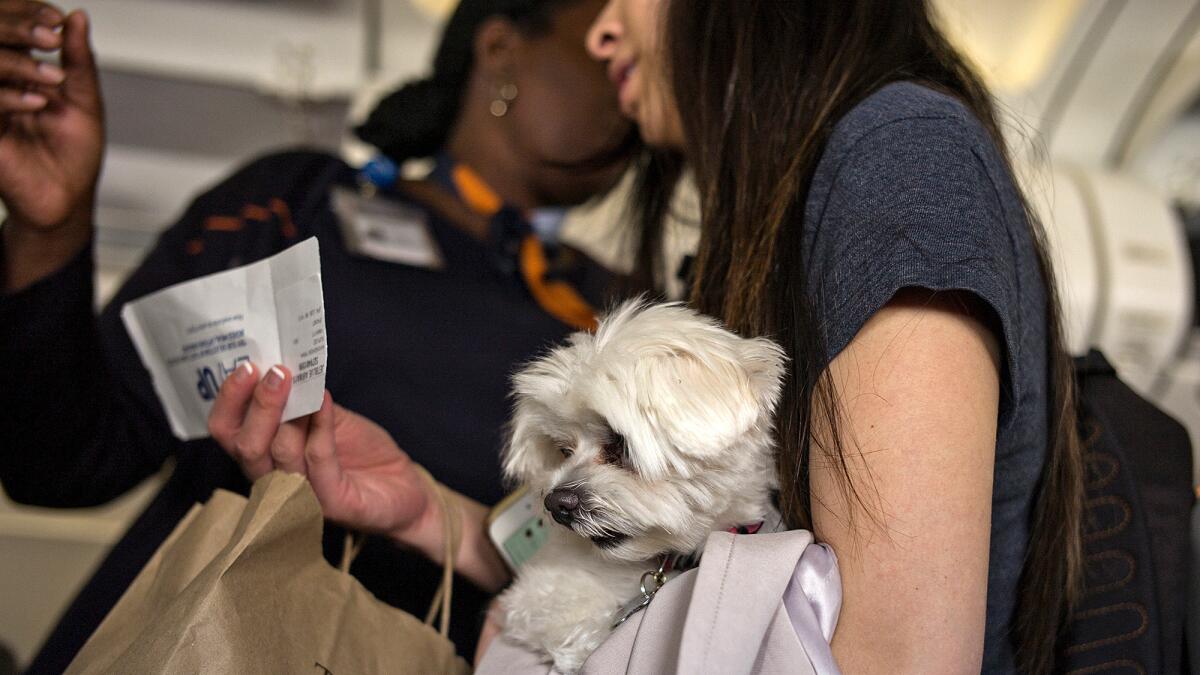So you want a letter saying you need a support dog on that flight? Here’s why a therapist might balk

A regal peacock was barred from accompanying its owner on a United Airlines flight departing from Newark, N.J., in January, but not, well, for being a regal peacock. It was simply too large.
Another flightless fowl, a turkey, got the go-ahead two years ago to fly with its owner on Delta Air Lines.
And then there was the mallard, wearing velcro red shoes, that became an internet celebrity when the duck was photographed in 2016 flying with its caretaker in North Carolina.
The animals that flew didn’t cost their owners a dime and didn’t spend their time locked up in a cage. Instead, the critters were deemed necessary by a medical professional to provide emotional support, which meant they could cuddle up in the laps of their presumably anxious owners — just inches from other fliers.
“This thing has gotten out of hand,” said Jeff Younggren, a psychologist and clinical professor at the University of New Mexico, who has conducted several studies on the subject of emotional support animals.

Of course, most support animals aren’t ducks or monkeys or anything else exotic. They are beloved household dogs and cats, but a consensus is emerging among airlines, federal regulators and some in the therapeutic community that there are far too many of them.
The number of passengers flying with emotional support animals on the nation’s airlines has surged. United Airlines, one of the biggest carriers, saw a 75% increase last year compared with 2016. The trend has been accompanied by more incidents of animals urinating, defecating, biting, barking and lunging on planes. A passenger was even mauled by a 50-pound dog on a Delta flight last year.
The increase has prompted several air carriers this year to require additional measures to travel with such animals, such as documentation submitted 48 hours in advance ensuring that the animals will not pose a safety hazard on the plane. Federal regulators also are considering adopting new rules, including limiting the species that can travel as emotional support animals.
Meanwhile, psychologists and therapists are wrestling with a surge in patients requesting written diagnoses that they need to fly with support animals.
“We don’t have existing standards for how to evaluate them,” said Younggren, who on a flight recently to Atlanta sat in front of a couple both cradling emotional support dogs.
Psychologists and airline officials blame the surge on passengers who are trying to take advantage of a gap in the federal Air Carrier Access Act, which allows people with mental-health disabilities to fly on a plane with an animal free of charge if it alleviates their condition.
The 1986 law fails to outline the guidelines and procedures for diagnosing a person who needs to be accompanied by an emotional support animal.
Before the latest crackdown, most airlines simply required passengers to produce a letter from a medical professional attesting to the need for the passenger to fly with an animal.
Receiving a letter from a therapist who certifies the need for an emotional support animal also lets renters — under the Fair Housing Act — keep an animal in a home or apartment that has a no-pets policy.

Emotional support animals are not required to have specific training, unlike service animals, which must complete training to be assigned to aid someone who is blind, deaf or has some other physical disability.
“What has happened is it has been a misuse of the grayness in the law,” said Aubrey Fine, a psychologist in Claremont and author of several books on animal-assisted therapy.
For psychiatrists, the “grayness” in the law puts them in an ethical bind: Do they write a letter that lets their patients fly with a pet even without diagnosis guidelines or do they deny the letter and create a conflict with a patient they must continue treating?
“I get this request quite often, at least once a month,” said Michi Fu, a psychologist based in Pasadena. “It puts me in a weird bind.”
There is no agreement among therapists on who should create the guidelines, though some psychologists suggest a professional organization, such as the American Psychological Assn., would be best suited to do the job. The association has responded to the dilemma by publishing an article that warns therapists to think twice before writing such diagnosis letters.
With many psychologists reluctant to write diagnosis letters, dozens of businesses have sprouted up on the internet, offering a written diagnosis that they say can be used to get animals on airplanes and in apartments that ban pets.
Such websites say they can provide a written diagnosis within 24 hours, via email, after only a five- to 10-minute phone conversation with a “mental health professional” plus a fee of as little as $80. Some sites also sell dog collars and leashes emblazoned with the words “support dog” for $15 to $22 each.
A site called United Support Animals proclaims: “Fly with your pet in the cabin of an airplane at no cost. Keep your pet in any housing even if there is a ‘no pet policy.’ Say goodbye to pet security deposits forever.” A representative for the website did not return calls for comment.
To help root out bogus diagnosis letters, United Airlines recently began to require that passengers who want to travel with an emotional support animal include the name and contact information of the mental health professional that diagnosed the passenger. The airline said it is contacting the mental health professional to verify the diagnosis letter.
“We want to work to prevent those who want to take advantage of that option,” said Charles Hobart, a spokesman for United Airlines.

Delta, American and Alaska, along with other airlines, have also imposed additional requirements, such as proof that the animal is healthy and not a threat to other passengers. Some airlines have banned certain species such as hedgehogs, goats, ferrets, chickens, birds of prey and snakes.
If the passengers meet the airline’s requirements, the fliers can keep the pets on their laps or at their feet in the cabin without paying the usual in-cabin animal transport fee, which can range from $75 to $200.
But meeting the new requirements may not be so easy. Julia Annin of Tiburon, Calif., said a major airline refused to let her fly with her emotional support dog on a recent flight from San Francisco to Rhode Island even though she had a legitimate letter from her therapist.
“They told me to my face that it was fake,” she said, adding that she was forced to pay to put her chihuahua-terrier mix dog in a carrier.
The controversy gets even murkier because some mental health experts say that scientific studies do not agree that animals play a therapeutic role when they fly with a patient.
“Little empirical data exists to support the conclusion that [emotional support animals] are effective in mitigating psychological disorders and related problems, and empirical research that does exist is inconsistent, sparse and emerging,” said a study by Younggren and two colleagues published by the American Psychological Assn. in 2016.
When asked to respond to the controversy, the American Psychological Assn. pointed to an article that appeared in the latest issue of Good Practice, a magazine the group publishes for practitioners.
The article, written by Connie Galietti, director of legal and professional affairs for the group, urged psychologists to think of the ethical and practical problems that may result from writing a diagnosis letter.
“Remember, your letter is stating that the patient’s diagnosis substantially impacts a life activity,” the article says. “Can you honestly and objectively make that determination? Does an [emotional support animal] truly minimize the impact of the patient’s problem, or is this just a way of allowing a beloved pet to be able to live with your patient, or allow the patient to avoid paying airline pet transport fees? If you have reservations about any of these issues, you probably shouldn’t write the letter.”
Allowing emotional support animals on a plane may alleviate the stress for one passenger but some therapists warn that the presence of an animal can create trauma for other passengers who have allergies or a fear of animals.
“You run the risk of having individuals that have phobias of dogs and they are exposed to the animals in a confined space,” said David A. Songco, a Milwaukee psychologist who says he has received many requests for diagnosis letters. “So there are many perspectives on this.”
Songco said he has rejected all but one request for a diagnosis. He said he felt comfortable writing a diagnosis letter for a woman he was treating specifically about her fear of flying.
Songco worries that the surge of requests for diagnosis letters will mean that people who legitimately need to travel with an emotional support animal will face more restrictions and added requirements for documentation.
Katelynn Ballard, a college student in Conway, Ark., was paired up with a German Shepherd about a year ago to help her cope with anxiety, depression and other mental-health issues.
She said her dog, Ares, was trained for months to come to her side when she begins to show symptoms of her disorder.
“I don’t think I could function and be the person that I am without him,” Ballard said, adding that she hasn’t flown on a commercial plane with the dog but is confident he would be a comforting travel partner.
“There are people who really need an emotional support animal,” she said. “I don’t feel it’s fair that people are ruining it for people who really need that.”
The U.S. Department of Transportation has been wrestling with the subject of animals on planes for years. In 2016, the agency created a committee of airline representatives and disabled-rights advocates to help decide what animals should be permitted on planes and what documents are required to prove the animals are needed.
The group, the Accessible Air Transportation Advisory Committee, could not reach a consensus and the panel was disbanded.
At the request of several airlines and advocacy groups, the department last month issued a new request for public comments before the agency tries again to adopt new rules to address the surge of animals on planes.
Brad Morris, director of government relations for a North Carolina group called Psychiatric Service Dog Partners, was a member of the previous committee and is not optimistic that a set of rules will be adopted that will make airlines and advocacy groups happy.
His group suggests airline passengers who want to fly with a service or emotional support animal be required to answer a series of online questions about themselves and their animal — eliminating the need to visit a therapist or psychologist. Morris suggested that penalties be imposed on people who lie on the questionnaire.
But he is not optimistic about an easy solution.
“Some people say a compromise is where everyone leaves unhappy with the solution,” Morris said. “That may be what happens here.”
To read more about the travel and tourism industries, follow @hugomartin on Twitter.
More to Read
Inside the business of entertainment
The Wide Shot brings you news, analysis and insights on everything from streaming wars to production — and what it all means for the future.
You may occasionally receive promotional content from the Los Angeles Times.









